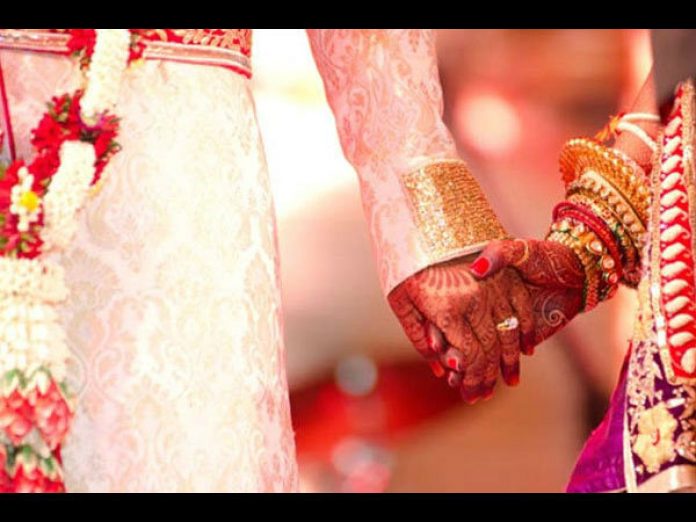This article is written by Gautam Chaudhary, a law student at Chander Prabhu Jain College of Higher Studies and School of Law, GGSIPU. The present article talks about the law relating to essential ceremonies of marriage as provided by Section 7 of the Hindu Marriage Act, 1955.
It has been published by Rachit Garg.
Table of Contents
Introduction
Marriage is said to be the union of two adults who come together with their families to form a union and, as a result, give an establishment to matrimony. In Indian society, this union is termed a ‘holy union’ because the people believe that this particular union is solemnised in the presence of the Gods who are summoned to the marriage through the recital of ‘mantras’. Upon arrival, they bless the marriage to be healthy and last till eternity. However, such unions are said to be complete when they are solemnised through certain traditional or customary ceremonies.
These ceremonies derive the force for their existence from the oldest spiritual texts of Hinduism, i.e., the Vedas. They are the oldest spiritual texts which lay down the rules about marriage in the Hindu religion, which also act as a direct source for contemporary Hindu marriage laws, wherein they provide that marriage under Hindu law has its own primary basis to hold on to. These are known as essential ceremonies and rituals for a valid and complete Hindu marriage. These ceremonies were essential and of paramount importance to solemnising a marriage under the Hindu religion to be considered done in the eyes of God. The ceremonies under Hindu law act as tools for the valid solemnization of Hindu marriage, and without their presence, a holy solemnization of marriage is not considered valid. Section 7 of the Hindu Marriage Act, 1955, talks about the ceremonies of a Hindu marriage. The present article elucidates the provisions and amendments given under the HMA.
The ancient concept of Hindu marriages
The old Hindu marriage in ancient India was guided by the old manuscript written by the sages, i.e., Manusmriti. Manusmriti provided the mandatory procedures, ceremonies, and forms of marriage to be performed in society. People used to solemnise marriages under these manuscripts only. Apart from the spiritual aspect, the marriages of ancient times were rigidly patriarchal since at that time only a man had a say in choosing his bride as per his choice whereas the girl was treated as a mere property upon which any man could claim his right for which various tournaments used to happen where the one who used to win the match was considered and chose to be a suitable husband for her. In ancient times, women did not have a say in their marriages. In ancient India, marriage was also endogamous, i.e., marrying only within the caste or social group, which was solemnized in furtherance of their traditions and to maintain the status of the group. This feature of marriage was also coupled with arranged marriages, wherein the family of the parties to the marriage had the authority to arrange a suitable bride or bridegroom for others. This practice was considered to be the utmost ‘sanskara’ to follow in the Hindu religion.
Forms of marriage in ancient India
In ancient India, there were various forms of marriage too, which were considered valid according to the Hindu religion. They were:
Brahma marriage
This form of marriage was considered to be above divine in nature because it showcased purity at the highest level where all religious activities took place. In this form of marriage, the father of the bride used to give her daughter, clothed with jewellery, to a man of good character who knew the Vedas and was of good family background.
Daiva marriage
The bride in this form of marriage was offered as ‘Dakshana’ only to a priest at the time of marriage. No specific qualification like good character and knowing Vedas was required in this form of marriage.
Arsha marriage
This form of marriage used to be completed when the father of the bride gave his daughter and, in exchange, received cattle or cows from the bridegroom. This practice was in place to perform and fulfil the sacred rule of marriage at that time.
Prajapatya marriage
Prajapatya’s form of marriage was different from the above-mentioned marriages since in this form of marriage the father of the bride used to worship the bridegroom and gave his daughter by saying “may you both together fulfil duties and responsibilities”. This was the only marriage ceremony that had to be performed at the time of marriage to have a valid effect.
Section 7 of Hindu Marriage Act
Section 7 of the HMA Act, 1955 says that there must be the performance of some spiritual ceremonies at the time of marriage. The section makes such performance mandatory for giving the status of husband and wife to the parties to a marriage in the eyes of the law.
Sub-section 1 of Section 7 states that at the time of marriage solemnization, there may be the performance of some customary rites and ceremonies of one of the parties. Upon the bare reading of the said Section, it can be comprehended that at the time of marriage, the husband or wife may perform some customary rites or ceremonies to render the solemnised marriage valid. It is to be noted that the present sub-section does not provide the kinds of ceremonies which must be performed at the time of marriage because of the multiple diversifying nature of Indian society. Therefore, the legislation made the texts of the sub-section discretionary in nature for parties to the marriage, where they may perform any ceremonies as per their traditions and customs. The use of the term “either of the parties thereto” makes clear that at the time of marriage, liberty is given to both parties or either one of them to perform the ceremonies.
Moving on to sub-section 2 of the present Section, sub-section 2 mainly lays out the procedure as to how ‘Saptapadi’ is completed. It is one of the holy ceremonies of marriage. The said sub-section states that where the performing ceremonies include Saptapadi, which means taking seven rounds in front of the holy fire, i.e., ‘Agni’ in the mandap, upon the completion of the seventh round, the marriage is said to be completed, which is of binding nature and is said to be a valid marriage. The term ‘binding’ mentioned in the present sub-section means that the wife and the husband are tied to each other and, in law, they belong to each other now, where neither of the parties can allege in the future that the other party is not his/her wife or husband and neither party can go out of this lawful tie according to his sole discretion and will. The only way to get out of this tie would be through a divorce.
State amendments to Section 7 of Hindu Marriage Act
The present Section was amended by the Madras Amendment Act, 1967, which provides provisions regarding ‘Suyamariyathai’ and ‘Seerthiruththa’ marriages that have existed in the state for over half a century. For this, Section 7-A was added, which provides the additional ceremonies to be performed at the time of marriage, which are:
- Each party may communicate with the other in the language understood by the other and convey that the party takes the opposite party to be their husband or wife.
- Each party may put a ring on the finger of another party or put a garland or ‘varmala’ on the neck of the bride or groom.
- The marriage may be solemnised by the tying of the thali, i.e., a sacred thread of gold worn by the married wife after marriage.
The above-mentioned Madras state amendment to the Hindu Marriage Act, 1955 only provides provisions for two marriages, namely, Suyamariyathai and Seerthiruththa. It provides that the marriage can be solemnised in the absence of a priest. If the priest is not present, then the marriage can be validly solemnized in front of friends, relatives, family, and other people, but in the said situation, the parties to the marriage must communicate with each other, admitting to taking him/her as husband/wife, putting the ring on the other party’s finger, and tying the thali, i.e., the sacred thread of gold, worn by the married wife after marriage.
The Hon’ble Supreme Court in S. Nagalingam vs. Sivagami, (2001) also held that Section 7-A will apply to those marriages where the parties to the marriage, i.e., bride and bridegroom, solemnise a marriage in the presence of parents, family, and friends. In order to solemnize a valid marriage under this special provision, the presence of a priest is not necessary. Furthermore, parties are also at full liberty to enter into a marriage where their parents, family, and friends are present at the time of marriage, but in such marriages, the bride and the bridegroom should communicate or declare to the other that he/she takes the other to be his lawful husband and wife. This requirement must also be coupled with the tying of the thali or putting a ring upon any finger of the other. After all this, a valid marriage shall be solemnised in the eyes of the law.
Different ceremonies accepted under Section 7 of Hindu Marriage Act
At the outset, in Smt. Bibbe vs. Smt. Ram Kali and Ors, (1982), the Hon’ble Allahabad High Court said that the ceremonies required to be performed at the time of marriage are not exclusively fixed. Moreover, if in case the ceremonies are performed at a certain marriage, it shall not be taken as the only ceremony or bunch of ceremonies prescribed by law. They vary according to the customs and traditions of the parties to the marriage.
In Ram Chandra Bhagat vs. the State of Jharkhand (2010), it was observed by the Hon’ble Supreme Court that an inter-caste marriage may be solemnised either following the customs and ceremonies of the boy’s caste or the girl’s caste.
The object of highlighting the above-stated judgments is to understand that in Hindu law, the solemnization of marriage is totally dependent on the customs and rites of the parties to the marriage. This is also provided in Section 7(1) of the Hindu Marriage Act, 1955, that the marriage may be solemnised either in accordance with ceremonies existing in customs or rituals of either party. Thus, it can be construed that there cannot be a straight jacket formula as regards what ceremonies are accepted under Section 7 because India is a place of multiple diversities and every community has its own rituals and customs to follow.
Although for a basic and highlighted understanding, the following are the ceremonies that are accepted for a valid solemnization of marriage:
Kanyadaan
The present term is made up of the union of two other terms, i.e., ‘kanyaa’ and ‘daan’. The former means a ‘girl’ and the latter means donation or giving away. At the time of marriage, the father of the bride performs this ceremony by giving his daughter to the groom along with the responsibility to protect, preserve, and nurture her. The present ceremony may be essential or mandatory for a valid marriage.
Sagai
Under the Hindu religion, the festivities of marriage begin on the day of ‘sagai’. Sagai is the ceremony in which the groom and the bride present rings to each other, and by doing so, they take a step ahead towards their holy union. A ring ceremony takes place in India just to embark or lock in the joyful union of the groom, bride, and their families.
Saptapadi
Saptapadi, which generally means taking seven steps around the holy fire under the mandap at the time of marriage, is a fundamental and common ceremony performed among various Hindu communities. Section 7(2) of the Hindu Marriage Act, 1955, gives out the general provision for Saptapadi, wherein it states that where rites and ceremonies include ‘saptapadi’ as a ceremony, then the marriage will be considered complete and valid upon the completion of the seventh round around the holy fire.
Homa
A Hindu marriage also includes the ceremony of ‘homa’ or in the spiritual term ‘vivah homa’ wherein, after the Kanyadaan, a sacred fire is lit in the havan kund and the chanting of mantras by the priest begins to worship the god of fire, i.e., ‘Agnidevta’ and to invite ‘Vishnu’ to the marriage to mark it as holy. In this ceremony, the bride and groom repeat the mantras of ‘santani’ for the wellness of children, ‘sampatti’ for good wealth and financial status, and ‘deergharogya’ for a happy and healthy life.
Pani Grahan
In Pani Grahan, the bridegroom holds the right hand of the bride and faces the west, while the bride faces the east side. After taking such a position, the bridegroom starts reciting the mantras given by the priest. The mantras involve promises of happiness, a long-lasting relationship between the parties to the marriage, and promises regarding household responsibility.
Landmark case laws
- In A. Asuvathaman vs. Union of India (2015), the Madras High Court in the year 2015 upheld the validity of Section 7-A of HMA. In the present case, the petitioner challenged the validity of the state’s amendment, terming it to be ultra-vires to Section 7 and completely against the principles of the Hindu religion. He also further submitted that the amendment has proved to be in violation of Article 14 of the Indian Constitution. The Court dismissed the petition, saying the amendment is just regarding two marriages, i.e., Suyamariyathai and Seerthiruththa, and thus it is not discriminatory in nature. The Court further held that there exists a presumption in favour of the constitutionality of the act unless the petitioner proves any grounds that are proven to be against any principle of the Constitution.
- In Bhaurao Shankar Lokhande vs. The State of Maharashtra (1965), the Hon’ble Supreme Court held that marriage is not said to be in existence if it is not celebrated or performed with the necessary customary ceremonies. A marriage shall be solemnized in the eyes of the law when it has been conducted while following the ceremonies of either of the parties. Further, the Court also held that merely after following certain ceremonies as per their will, the parties cannot be said to be married because such a ceremony will not be recognized by law and customs. What has to be noted is that the ceremonies must be conducted in practice according to the parties’ customs and traditions.
- In Sumit Subhash Agarwal vs. Kamalesh Lalita Prasad Gupta (2018), the Hon’ble Bombay High Court held that taking pheras around a bunch of agarbattis is considered Saptapadi and so constitutes a valid marriage.
- In Shri. Nitin S/O. Omprakash vs. Smt. Rekha W/O. Nitin Agrawal (2017), the Hon’ble Bombay High Court observed that having a physical relationship along with the application of sindoor on a woman’s forehead and tying of mangalsutra does not constitute a valid marriage.
- In Surjit Kaur vs. Garja Singh (1993), the Hon’ble Supreme Court held that living together for a long time without any performance of holy ceremonies would not constitute a valid marriage.
- In S. Nagalingam vs. Sivagami (2001), the Hon’ble Supreme Court held that the ceremony of Saptapadi is essential where the parties admit it to be essential. And where Saptapadi is not performed but other ceremonies have been performed according to the custom of either party, a valid marriage has been solemnized.
Conclusion
In order to solemnise a valid marriage in the eyes of the law, one must perform not all but some of the ceremonies. The Hindu Marriage Act, 1955 gives liberty to either of the parties to perform the necessary ceremonies to give marriage a valid effect. Further, the law does not provide or have a straight jacket formula as to what these necessary ceremonies are, the reason being the diverse nature of Indian society. What is necessary is that the ceremony, either on the bride’s side or on the groom’s, must be necessary and of the utmost importance to solemnize or complete a marriage. The same was said by the Apex court in Surjit Kaur vs. Garja Singh (1993), which held that living together for a long time without any performance of holy ceremonies would not constitute a valid marriage.
Frequently Asked Questions (FAQs)
Would non-performance of the ceremonies render the marriage invalid?
The non-performance of essential ceremonies will completely render the marriage invalid since, according to the Hindu religion, the performance of ceremonies like Saptapadi is necessary to solemnize a valid marriage.
Is Section 7 mandatory in nature?
Section 7 of the HMA holds mandatory force in terms of a valid marriage. There is no presence of discretion as to whether to perform ceremonies or not.
Why was Section 7-A added to the Hindu Marriage Act, 1955 by the Madras government?
Section 7-A was added by the state government through an amendment just to specially provide provisions for marriages, i.e., Suyamariyathai and Seerthiruththa. The said provisions were introduced just to give a legal framework to these marriages, which had been in practice for a long time in the state.
References
- http://www.patnalawcollege.ac.in
- https://www.financialexpress.com/lifestyle/hindu-marriage-act-married-without-taking-saath-pheras-find-out-if-your-marriage-is-legally-valid/1579979/
- https://www.lawcolumn.in/ceremonies-of-hindu-marriage-section-7-of-hindu-marriage-act/
Students of Lawsikho courses regularly produce writing assignments and work on practical exercises as a part of their coursework and develop themselves in real-life practical skills.
LawSikho has created a telegram group for exchanging legal knowledge, referrals, and various opportunities. You can click on this link and join:
Follow us on Instagram and subscribe to our YouTube channel for more amazing legal content.
 Serato DJ Crack 2025Serato DJ PRO Crack
Serato DJ Crack 2025Serato DJ PRO Crack












 Allow notifications
Allow notifications



